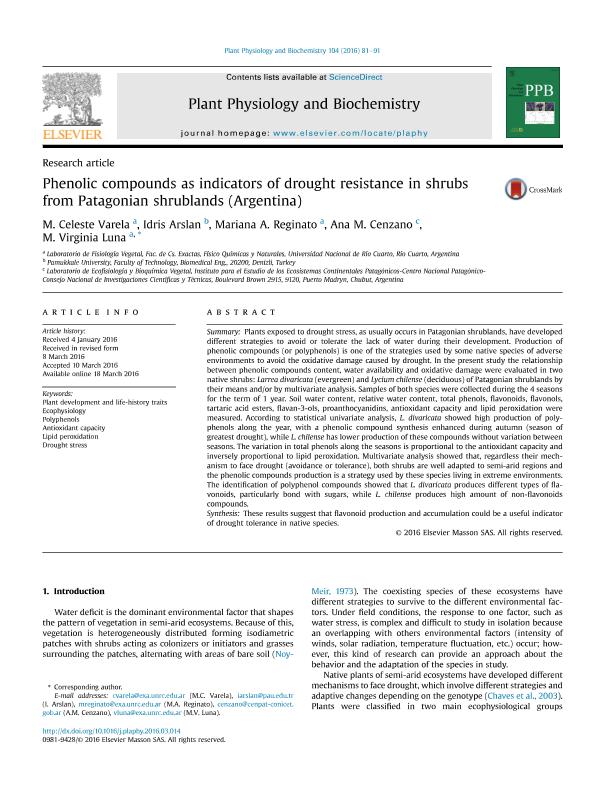Mostrar el registro sencillo del ítem
dc.contributor.author
Varela, María Celeste

dc.contributor.author
Arslan, Idris
dc.contributor.author
Reginato, Mariana Andrea

dc.contributor.author
Cenzano, Ana María

dc.contributor.author
Luna, María Virginia

dc.date.available
2022-11-30T18:33:38Z
dc.date.issued
2016-03
dc.identifier.citation
Varela, María Celeste; Arslan, Idris; Reginato, Mariana Andrea; Cenzano, Ana María; Luna, María Virginia; Phenolic compounds as indicators of drought resistance in shrubs from Patagonian shrublands (Argentina); Elsevier France-Editions Scientifiques Medicales Elsevier; Plant Physiology and Biochemistry; 104; 3-2016; 81-91
dc.identifier.issn
0981-9428
dc.identifier.uri
http://hdl.handle.net/11336/179625
dc.description.abstract
Summary: Plants exposed to drought stress, as usually occurs in Patagonian shrublands, have developed different strategies to avoid or tolerate the lack of water during their development. Production of phenolic compounds (or polyphenols) is one of the strategies used by some native species of adverse environments to avoid the oxidative damage caused by drought. In the present study the relationship between phenolic compounds content, water availability and oxidative damage were evaluated in two native shrubs: Larrea divaricata (evergreen) and Lycium chilense (deciduous) of Patagonian shrublands by their means and/or by multivariate analysis. Samples of both species were collected during the 4 seasons for the term of 1 year. Soil water content, relative water content, total phenols, flavonoids, flavonols, tartaric acid esters, flavan-3-ols, proanthocyanidins, antioxidant capacity and lipid peroxidation were measured. According to statistical univariate analysis, L. divaricata showed high production of polyphenols along the year, with a phenolic compound synthesis enhanced during autumn (season of greatest drought), while L. chilense has lower production of these compounds without variation between seasons. The variation in total phenols along the seasons is proportional to the antioxidant capacity and inversely proportional to lipid peroxidation. Multivariate analysis showed that, regardless their mechanism to face drought (avoidance or tolerance), both shrubs are well adapted to semi-arid regions and the phenolic compounds production is a strategy used by these species living in extreme environments. The identification of polyphenol compounds showed that L. divaricata produces different types of flavonoids, particularly bond with sugars, while L. chilense produces high amount of non-flavonoids compounds. Synthesis: These results suggest that flavonoid production and accumulation could be a useful indicator of drought tolerance in native species.
dc.format
application/pdf
dc.language.iso
eng
dc.publisher
Elsevier France-Editions Scientifiques Medicales Elsevier

dc.rights
info:eu-repo/semantics/openAccess
dc.rights.uri
https://creativecommons.org/licenses/by-nc-sa/2.5/ar/
dc.subject
PLANT DEVELOPMENT
dc.subject
ECOPHYSIOLOGY
dc.subject
POLYPHENOLS
dc.subject
ANTIOXIDANT CAPACITY
dc.subject
LIPID PEROXIDATION
dc.subject
DROUGHT STRESS
dc.subject.classification
Otras Ciencias Biológicas

dc.subject.classification
Ciencias Biológicas

dc.subject.classification
CIENCIAS NATURALES Y EXACTAS

dc.title
Phenolic compounds as indicators of drought resistance in shrubs from Patagonian shrublands (Argentina)
dc.type
info:eu-repo/semantics/article
dc.type
info:ar-repo/semantics/artículo
dc.type
info:eu-repo/semantics/publishedVersion
dc.date.updated
2022-11-30T12:06:01Z
dc.journal.volume
104
dc.journal.pagination
81-91
dc.journal.pais
Francia

dc.journal.ciudad
Paris
dc.description.fil
Fil: Varela, María Celeste. Universidad Nacional de Río Cuarto. Facultad de Ciencias Exactas, Fisicoquímicas y Naturales. Departamento de Ciencias Naturales; Argentina. Consejo Nacional de Investigaciones Científicas y Técnicas. Centro Científico Tecnológico Conicet - Córdoba; Argentina
dc.description.fil
Fil: Arslan, Idris. Pamukkale University; Turquía
dc.description.fil
Fil: Reginato, Mariana Andrea. Universidad Nacional de Río Cuarto. Facultad de Ciencias Exactas, Fisicoquímicas y Naturales. Departamento de Ciencias Naturales; Argentina. Consejo Nacional de Investigaciones Científicas y Técnicas. Centro Científico Tecnológico Conicet - Córdoba; Argentina
dc.description.fil
Fil: Cenzano, Ana María. Consejo Nacional de Investigaciones Científicas y Técnicas. Centro Nacional Patagónico; Argentina
dc.description.fil
Fil: Luna, María Virginia. Universidad Nacional de Río Cuarto. Facultad de Ciencias Exactas, Fisicoquímicas y Naturales. Departamento de Ciencias Naturales; Argentina. Consejo Nacional de Investigaciones Científicas y Técnicas. Centro Científico Tecnológico Conicet - Córdoba; Argentina
dc.journal.title
Plant Physiology and Biochemistry

dc.relation.alternativeid
info:eu-repo/semantics/altIdentifier/doi/http://dx.doi.org/10.1016/j.plaphy.2016.03.014
dc.relation.alternativeid
info:eu-repo/semantics/altIdentifier/url/https://www.sciencedirect.com/science/article/abs/pii/S0981942816300808
Archivos asociados
